
Thanksgiving Day. My most favorite of all holidays. I love the smell of the turkey roasting, the pumpkie pies baking, the rich sweet-tart aroma of cranberry sauce … Too, it's a time of sharing with loved ones, of enjoying simple company, of being thankful for what I do have, and not have to concern myself with the commercialism of other holidays, like Christmas.
To many, the word Thanksgiving evokes visions of a large linen-covered dinner table, with several delicious foods laid upon it, a cornucopia gracing the center, mom's best china and silver set neatly at each place setting. Although other cultures have forms of a thanksgiving, the Thanksgiving that is most known is that which is entirely an American tradition and holiday, evolving through the years to become what it is today, celebrated on the last Thursday of each November. Observance of Thanksgiving in Canada, officially established in 1879, is celebrated on the second Monday in October.
The scenario is typical across the vast land known as the United States. On Thanksgiving morning, Moms rise early to being preparation for the feast, bustling about their kitchens, preparing the turkey, pumpkin pies, cranberry sauce, candied yams, fruit salads, and many other delicious dishes, men gather round the television set, watching the traditional football games, while children run underfoot. When the dinner is ready, American families gather around tables and give thanks for the blessing of the past year, in honor of that day when the Pilgrims first set aside an occasion to thank God for a plentiful harvest.
Of course, many things found common at today's meal was not even known when the pioneers who arrived on American shores, such as utensil, furniture, and even proper table manners. For these early settlers, spending the time to sit down and give thanks was not the lengthy meal we enjoy today; there was simply too much to be done. With the coming winter, food stores needed to be prepared to last throughout the season.
The dinner table was, of course, not as elaborate as found today. In the days of the settlers, tables were made from simple planks of wood, and often times there weren't any chairs. As a result, the family members literally ate on the run. Dinnerware, too, was hard to come by; fingers were often the tools of eating. Forks were unknown until the sometime in the mid 1700's. Often spoons were carved out of wood, and more elaborate spoons were made from things like seashells and walnut shells, with twig handles attached. Pewter came much later in time and was quite expensive.
In the times of the pilgrims, the most common way to eat food was from a trencher — square blocks of wood in which bowls have been formed by hollowing out one side. The other side of the wood was generally flat, so that, say, a piece of pie could be eaten upon it. One side of the trencher held the main course, while the other side held dessert. Of course, many trenchers didn't even get this fancy. Often, families would use stale bread rather than precious wood. In this case, the food, once poured on the bread, could be entirely consumed, trencher and all cialis canada. Cups were usually shared around a table; made of wood and called a "noggin," the most common drink was cider.
Not only is the manner in which we eat today different than that of the pioneers, but also the foods we automatically deem as part of a traditional Thanksgiving table is different. The depiction of turkey and cranberry sauce decorating one long table stem solely from the creative musings of a magazine editor in the mid-1800s. These pioneers came from many countries, mostly originating from Europe, such as the English, who came to Virginia in 1607 and New England in 1620, and the English Quakers who established a settlement in Pennsylvania in 1681; the Germans, who also settled in Pennsylvania in approximately 1690; the Dutch, who established their homes in New York in 1623; and, the Swedish and Finnish who claimed Delaware their new home in the 1620's.
These early pioneers found that America was indeed the land of plenty. However, many of the plants were unfamiliar to the Europeans. Only with the help of the Native Americans who lived upon the land, were the settlers able to survive. These Native Americans (or Indians, as they were called, based on the inaccurate supposition that explorers had landed in India) introduced to the early settlers such foods as lima beans, peppers, pumpkins, squash, sweet potatoes and corn, into the normal diet of the settlers consisting of cabbage, parsnips and herbs. The settlers discovered a wilderness of game animals which included deer, moose, elk, rabbits and squirrels. Fruits, such as mulberries, cherries, grapes and walnuts, were in abundance. Corn, however, was the crucial vegetable, which could be roasted, boiled, made into pudding and, most importantly, ground into flour for making bread. Too, the Native Americans taught the settlers to how to grow such vegetables as beans and cornstalks, thereby saving precious land and space.
Let's explore some of these food differences from the days of the early settlers to today's traditional meal.
Although there are many types of poultry which could be found in the New World, only one is truly associated with Thanksgiving Day — the turkey. In fact, Benjamin Franklin deemed the turkey such a noble bird that he wanted it to be the national bird of America, rather than the eagle. The only two contemporary accounts of that first Thanksgiving mention "fowl" and "wild turkies" however, the fowl we know today as the turkey was most probably not one of the items found on the tables. It's safe to say that "fowl" and "wild turkies" most likely refer to geese, ducks, and pheasants (such as guinea fowl), rather than the wild North American turkey. Wild turkeys can be quite large, some weighing well over 30 pounds. These wild birds often travel in flocks. In contrast to today's domesticated turkey, the wild turkey had a beautiful purple and bronze colored plummage. No doubt the feathers were greatly prized as well.
Corn on the cob was another food item that was probably not found at that first Thanksgiving, since Indian corn was primarily used only for grinding up into meal. Pumpkin pie would have been absent as well, since the Pilgrims had no ready supply of flour, however, they could have made something like a pudding from boiled pumpkin sweetened with honey or syrup. Squash and sweet potatoes are native to the New World, and a staple of the diet of the Native Americans, however, the white potatoes, which we today bake and mash, were not introduced to the New World until the 1700's. Tomatoes, that wonderful treat we add to salads and use for sauces, were thought to be poisonous and people refused to eat them until after the American Revolution.
The Story of the First Thanksgiving
"Pilgrims" is the collective name for the first group of permanent European settlers in New England. However, the peoples that made up this group each held their own differences among the 102 people (one third of them were children) who stepped ashore at Plymouth in 1620. They were a group divided between Saints, those with religious reasons for leaving home, and Strangers, those with economic motives. However, despite their differences, they created the Mayflower Compact, an agreement in which decreed they would live peacefully together.
The story of the Mayflower's journey began in the English village of Scrooby. A large group of Separatists (or, more familiarly, Puritans), emigrated from Scrooby to Leiden, Holland. However, after a few years they began to desire a land of their own where they could live as Englishmen and yet preserve their faith. When news about the thriving English colony at Jamestown in Virginia, this group applied to the Virginia Company for a patent, and were granted rights to found what was known as a Particular Plantation, to be located somewhere near the mouth of the Hudson River.
The Separatists, unable to finance an expedition themselves, allowed a group of merchant capitalists who called themselves the Company of Adventurers to provide the necessary finances in exchange for a greater share of the profits earned by the colony during the first seven years of its operation. These merchants then chartered a ship called the Mayflower for the voyage to this New World. The Leiden group purchased a small ship known as the Speedwell and 35 of this congregation sailed on it from the Netherlands to Southampton, England. There at Southampton the Leiden congregation met with the rest of the future colonists, who were non-Separatists enlisted by the company to provide enough people for a working colony. This is how the names "Saints" and "Strangers" came about. The Leiden congregation of Separatists referred to this group of non-Separatists as Strangers, while the Separatists referred to themselves as Saints. This ragtag group of future colonists, numbering approximately one hundred twenty (120) in all, ninety (90) aboard the Mayflower, the remainder on the Speedwell, set sail from Southampton on August 15th. After a few days sailing, the Speedwell was found to have leaks, and both captains turned back, sailing into Dartmouth for repairs. After approximately two weeks later they set out once more. However, once again, the Speedwell proved to be unseaworthy, and this time they made port into Plymouth, where it was decided to abandon the ship; approximately twenty (20) would-be colonists were also abandoned, since the Mayflower could not hold all of them. At last, on September 16th, the Mayflower set out alone for America.
William Bradford listed the ship's passengers as follows:
Mr. John Carver; Kathrine, his wife; Desire Minter; & 2 man-servants, John Howland, Roger Wilder; William Latham, a boy; & a maid servant, & a child yt was put to him, called Jasper More. Mr. William Brewster; Mary, his wife; with 2. sons, whose names were Love & Wrasling; and a boy was put to him called Richard More; and another of his brothers. The rest of his childeren were left behind, & came over afterwards. Mr. Edward Winslow; Elizabeth, his wife; & 2. men servants, caled Georg Sowle and Elias Story; also a litle girle was put to him, caled Ellen, the sister of Richard More.
William Bradford, and Dorothy, his wife; having but one child, a sone, left behind, who came afterward. Mr. Isaack Allerton, and Mary, his wife; with 3. children, Bartholmew, Remember, & Mary; and a servant boy, John Hooke. Mr. Samuell Fuller, and a servant, caled William Butten. His wife was [left] behind, & a child, which came afterwards. John Crakston, and his sone, John Crakston. Captin Myles Standish, and Rose, his wife. Mr. Christopher Martin, and his wife, and 2. servants, who were Salamon Prower and John Langemore. Mr. William Mullines, and his wife, and 2. children, Joseph & Priscila; and a servant, Robart Carter. Mr. William White, and Susana, his wife, and one sone, caled Resolved, and one borne a ship-board caled Perigriene; & 2. servants, named William Holbeck & Edward Thomson.
Mr. Steven Hopkins, & Elizabeth, his wife, and 2. children, caled Giles, and Constanta, a doughter, both by a former wife; and 2. more by this wife, caled Damaris & Oceanus; the last was borne at sea; and 2. servants, called Edward Doty and Edward Litster. Mr. Richard Warren; but his wife and childeren were lefte behind, and came afterwards. John Billinton, and Elen, his wife; and 2. sones, John & Francis. Edward Tillie, and Ann, his wife; and 2. children that were their cossens, Henery Samson and Humillity Coper. John Tillie, and his wife; and Eelizabeth, their dougter. Francis Cooke, and his sone John. But his wife & other children came afterwards. Thomas Rogers, and Joseph, his sone. His other children came afterwards. Thomas Tinker, and his wife, and a sone.
John Rigdale, and Alice, his wife. James Chilton, and his wife, and Mary, their dougter. They had an other doughter, yt was maried, came afterward. Edward Fuller, and his wife, and Samuell, their sonne. John Turner, and 2. sones. He had a doughter came some years after to Salem, wher she is now living. Francis Eaton, and Sarah, his wife, and Samuell, their sone, a yong child. Moyses Fletcher, John Goodman, Thomas Williams, Digerie Preist, Edmond Margeson, Peter Browne, Richard Britterige, Richard Clarke, Richard Gardenar, Gilbart Winslow. John Alden was hired for a cooper, at South-Hampton, wher the ship victuled; and being a hopefull yong man, was much desired, but left to his owne liking to go or stay when he came here; but he stayed, and maryed here. John Allerton and Thomas Enlish were both hired, the later to goe mr [master] of a shalop here, and ye other was reputed as one of ye company, but was to go back (being a seaman) for the help of others behind. But they both dyed here, before the shipe returned. Ther were allso other 2. seamen hired to stay a year here in the country, William Trevore, and one Ely. But when their time was out, they both returned.
These, bening aboute a hundred sowls, came over in this first ship; and began this worke, which God of his goodnes hath hithertoo blesed; let his holy name have ye praise. Although 102 Pilgrims sailed from England, one died and another was born during the voyage. So 102 reached the harbor at Provincetown, Mass. Four more died and one was born there. The group that landed at Plymouth consisted of 99 Pilgrims."
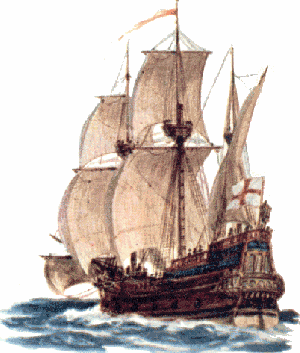 |
There were 102 passengers aboard the Mayflower. The majority of the passengers were Anglicans, mostly from southeastern England or from London itself. These included Captain Myles Standish, Priscilla Mullins, and John Alden. The Mayflower voyage was a difficult one. Many people perhaps think that those who came on the Mayflower were old men and women. This was not true. William Brewster, who was the oldest of all the Pilgrims, was under age fifty-five. Most of the adults were in their twenties and thirties, and about one-third (1/3) of all passengers on the Mayflower were children. As there were no birth certificates, it is difficult to determine exact ages. The best that can be done is to estimate, utilizing everything written about the pilgrims at that time or soon after. |
Conditions on board were harsh. The ship, due to the delays caused by the Speedwell, crossed the Atlantic later than planned and happened upon severe storms before reaching land some sixty-six (66) days later. Many people became ill and all were confined below deck for long periods of time during the furious storms. The ship was blown of course by these storms so the land eventually sighted by those on board was Cape Cod, far north and east of the Hudson River. Finally, on November 11, 1620, the Mayflower came to rest off Cape Cod.
Realizing that the terms of their agreement applied to Virginia, not New England, the leaders of the two groups, the Saints and the Strangers, drafted the Mayflower Compact. In this historic document, signed on board the ship within sight of land, they stated their intention to remain a unity and to enact laws for the "general good" of the new colony. The Compact established the basic form of government for this new colony.
The Mayflower Compact
"In the name of God, Amen. We, whose names are underwritten, the Loyal Subjects of our dread Sovereign Lord, King James, by the Grace of God, of England, France and Ireland, King, Defender of the Faith, etc.
"Having undertaken for the Glory of God, and Advancement of the Christian Faith, and the Honour of our King and Country, a voyage to plant the first colony in the northern parts of Virginia; do by these presents, solemnly and mutually in the Presence of God and one of another, covenant and combine ourselves together into a civil Body Politick, for our better Ordering and Preservation, and Furtherance of the Ends aforesaid; And by Virtue hereof to enact, constitute, and frame, such just and equal Laws, Ordinances, Acts, Constitutions and Offices, from time to time, as shall be thought most meet and convenient for the General good of the Colony; unto which we promise all due submission and obedience.
"In Witness whereof we have hereunto subscribed our names at Cape Cod the eleventh of November, in the Reign of our Sovereign Lord, King James of England, France and Ireland, the eighteenth, and of Scotland the fifty-fourth. Anno Domini, 1620."
William Bradford, the leader of the Saints, recorded the bleak sight that met the Pilgrims after their stormy voyage:
"Being thus passed the vast ocean, and a sea of trouble … they had now no friends to welcome them nor inns to entertain or refresh their weather-beaten bodues … And for the season, it was winter, and they that know the winters of that country know them to be sharp and violent, and subject to cruel and fierce storms … For summer being done, all things stand upon them with a weatherbeaten face, and the whole country full of woods and thickets, represented a wild and savage hue. If they looked behind them, there was the mighty ocean which they had passed and was now as a main bar and gulf to separate them from all the civil parts of the world."
|
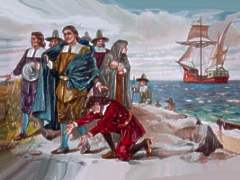 |
Because Cape Cod was unsuitable for settlement, several men set out in a smaller boat in search of a better place to claim. By the time they had decided upon a suitable place, it was mid-December. That sheltered harbor and well-cleared land became Plymouth, and the pilgrims soon began building their settlement on the slope of a hill overlooking the harbor. Sometime later, they discovered that this was the site of a Patuxet Indian village whose inhabitants had died of disease.
In this new land, these early settlers had to survive through a bitter and harsh winter. Sickness had thinned the population during this time as well by half. Of the fifty (50) people who survived this first terrible winter, over half were children and there were only four women. As time passed, life grew better. In the spring of 1621, the colonists planted their first crops in Patuxet's abandoned fields. Though they had limited success with wheat and barley, their corn crop proved very successful, thanks to Squanto (Tisquantum) who taught them how to plant corn in hills, using fish as a fertilizer. The settlers were enjoying relatively good health and houses were being buildt. They enjoyed peaceful relations with the natives of this new land, having made friends with them, signing a long-lasting peace treaty with Massasoit, head chief of the Wampanoags. In William Bradford's words:
"… In two or three months' time half of their company died. especially in January and February, being the depth of winter, and wanting houses and other comforts; being infected with the scurvy and other diseases which this long voyaage … had brought them. So as there died as many as two or three of a day in the foresaid time, that of a 100 and odd persons, scarce 50 remained."
The seeds which were sewn early that spring had produced a harvest which provided them with bountiful rations for the upcoming winter. Because of their good fortune, the Pilgrims decreed a holiday on which all might, "after a more special manner, rejoice together." And so, in approximately October, 1621,1 the pilgrims held the first Thanksgiving festival of the New World at Plymouth, Massachusetts. The pilgrims' first Thanksgiving is steeped in myth and legend. What has come down in American tradition as the "First Thanksgiving" was actually a harvest festival. The pilgrims would not have called these festivities a "Thanksgiving." The Separatists recognized only three kinds of holidays sanctioned by the Bible: the Sabbath, days of thanksgiving, and fast days. Unlike the Sabbath, days of thanksgiving and fast days were not part of the established calendar, but were proclaimed by the governor only in response to a specific situation. For example, a religious day of fasting could be invoked by a drought or war, and a religious day of thanksgiving could be called to celebrate a particularly good harvest or providential rainfall. Although the event of 1621 is known today as the "First Thanksgiving," that harvest feast had many secular elements and would not have been considered a religious day of thanksgiving by the Pilgrims. The pilgrims celebrated their first harvest with feasting and games, as was the custom in England, as well as prayer. The celebration served to boost the morale of the remaining colonists and also to impress their allies.
Governor Bradford sent four men to shoot waterfowl and wild turkeys. The women worked hard cooking the food. Chief Massasoit was invited to the feast, and he brought with him ninety brightly painted braves — about four times the number of Pilgrim men! Some of Massasoit's men made themselves useful by going into the forest and bringing back five deer.
It was an open-air festival, held in the field along the north bank of Town Brook. There were games of skill and chance. There was target shooting with bows and arrows and firearms. The Native Americanss entertained the pilgrims with some of their dances. It is said that Captain Miles Standish staged a military review of his small force. The festivities lasted for three days. The pilgrims and their guests enjoyed such foods as venison cooked on a spit over a blazing open fire, roast waterfowl such as ducks and geese, fish such as cod and bass, barley, groundnuts baked in hot ashes, herbs, corn pones, and corn-rye bread. Also available was cranberries, though it's uncertain whether the pilgrims had discovered yet how to use these tart berries. If indeed cranberries were served, they would have been used for their tartness or color, and not the sweet sauce or relish so common today; it would be at least fifty (50) or more years before these berries were boiled with sugar and used as an accompaniment to meat. A couple of guesses can be made from other passages in Winslow's correspondence about the general diet at the time: lobsters, mussels, "sallet herbs," white and red grapes, black and red plums, and flint corn.
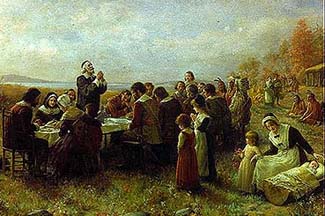 |
There are only two contemporary accounts of the 1621 Thanksgiving.
The first is that of Edward Winslow's account, which he wrote in a letter dated December 12, 1621. The complete letter was first published in 1622, Chapter 6 of Mourt's Relation: A Journal of the Pilgrims at Plymouth. |
"Our corn [i.e. wheat] did prove well, and God be praised, we had a good increase of Indian corn, and our barley indifferent good, but our peas not worth the gathering, for we feared they were too late sown. They came up very well, and blossomed, but the sun parched them in the blossom. Our harvest being gotten in, our governor sent four men on fowling, that so we might after a special manner rejoice together after we had gathered the fruit of our labors. They four in one day killed as much fowl as, with a little help beside, served the company almost a week. At which time, amongst other recreations, we exercised our arms, many of the Indians coming amongst us, and among the rest their greatest king Massasoit, with some ninety men, whom for three days we entertained and feasted, and they went out and killed five deer, which they brought to the plantation and bestowed on our governor, and upon the captain and others. And although it be not always so plentiful as it was at this time with us, yet by the goodness of God, we are so far from want that we often wish you partakers of our plenty."
The second description was written some twenty years after that first thanksgiving William Bradford in his History Of Plymouth Plantation. This written account was rediscovered in 1854 after having been stolen by the British during the Revolutionary War.2
"They began now to gather in the small harvest they had, and to fit up their houses and dwellings against winter, being all well recovered in health and strength and had all things in good plenty. For as some were thus employed in affairs abroad, others were exercising in fishing, about cod and bass and other fish, of which they took good store, of which every family had their portion. All the summer there was no want; and now began to come in store of fowl, as winter approached, of which this place did abound when they came first (but afterward decreased by degrees). And besides waterfowl there was great store of wild turkeys, of which they took many, besides venison, etc. Besides they had about a peck of meal a week to a person, or now since harvest, Indian corn to that proportion. Which made many afterwards write so largely of their plenty here to their friends in England, which were not feigned but true reports."
Did the pilgrims repeat this holiday? There are various controversies and arguments on this subject. It is certain that the pilgrims did not celebrate Thanksgiving the next year, or any year thereafter, however what probably is the root of the confusion, is that some of their descendants later established a "Forefather's Day" that generally took place on December 21 or 22.
In is also factual that in 1789 George Washington, proclaimed a day of Thanksgiving, however it was only a one-time event, which sole purpose was to celebrate the new Constitution, and wasn't made an annual event, as Washington's successors let it drop completely.
In 1827, Mrs. Sarah Josepha Hale, editor of Godey's Lady's Book, decided to do something about it. In her magazine, Hale wrote appealing articles about roasted turkeys, savory stuffing, and pumpkin pies — all the foods that today's thanksgiving tables are likely to behold. In the process, she created holiday traditions that share few similarities with the original feast in 1621. For over thirty years, she wrote letters to the governors and presidents, lobbying for the instatement of Thanksgiving as a national holiday, asking them to make Thanksgiving Day a national holiday. Finally, in 1863, Abraham Lincoln issued his "1863 Thanksgiving Proclamation" and declared the last Thursday of November "as a day of Thanksgiving and Praise to our beneficent Father who dwelleth in the Heavens." Setting apart the last Thursday of November for the purpose, the President urged prayers in the churches and in the homes to "implore the interposition of the almighty had to heal the wounds of the nations and to restore it … to full enjoyment of peace, harmony, tranquility and union." He also states that they express heartfeld thanks for the "blessing of fruitful fields and healthful skies."
In 1939 President Franklin D. Roosevelt advanced Thanksgiving Day one week. However, two years later, the date was changed to the fourth Thursday in November. The reason given was that since some states used the new date and others the old, however, the real reason for the date change was commercialism. Roosevelt had hoped to coddle the retailers, who insisted they needed more time to prepare for the Christmas season and the rush to purchase gifts. Of course, this date change outraged a few notable Republicans, who claimed Roosevelt was trampling on sacred traditions. In 1941, this unpopular move inspired Congress to permanently fix the date on the fourth Thursday of November.
__________________________
1The Pilgrims' first Thanksgiving began at some unknown date between September 21 and November 9, most likely in very early October. The date of Thanksgiving was probably set by Lincoln to somewhat correlate with the anchoring of the Mayflower at Cape Cod, which occurred on November 21, 1620 (by our modern Gregorian calendar — it was, however, November 11 to the Pilgrims, who used the Julian calendar).
2The discovery of Bradford's written account prompted American interest in the history of the pilgrims, which led to Lincoln's decision to make Thanksgiving a holiday of Americans. It is also in this account that the Thanksgiving turkey tradition is firmly founded.

The idea of Thanksgiving did not originate with the pilgrims; it was an ancient historical custom they would have been familiar with from England — a harvest festival full of "revelry, sports, and feast." Throughout history mankind has celebrated the bountiful harvest with thanksgiving ceremonies. Before the establishment of formal religions many ancient farmers believed that their crops contained spirits which caused the crops to grow and die. Many believed that these spirits would be released when the crops were harvested and they had to be destroyed or they would take revenge on the farmers who harvested them. Some of the harvest festivals celebrated the defeat of these spirits. Harvest festivals and thanksgiving celebrations were held by the ancient Greeks, the Romans, the Hebrews, the Chinese, and the Egyptians.
The Chinese
The ancient Chinese celebrated an annual harvest festival, called Chung Ch'ui, with the full moon that fell on the 15th day of the 8th month. This day was considered the birthday of the moon and special "moon cakes" (round and yellow like the moon), would be baked. Each cake was stamped with the picture of a rabbit as it was a rabbit, not a man, which the Chinese saw on the face of the moon. The families ate a thanksgiving meal and feasted on roasted pig, harvested fruits and the moon cakes. It was believed that during this three day festival, flowers would fall from the moon and those who saw them would be rewarded with good fortune. Also, according to legend Chung Ch'ui also gave thanks for another special occasion. China had been conquered by enemy armies who took control of the Chinese homes and food. The Chinese found themselves homeless and with no food and many starved. In order to free themselves, they decided to attack the invaders. The women baked special moon cakes which were distributed to every family. In each cake was a secret message which contained the time for the attack. When the time came the invaders were surprised and easily defeated. Today, moon cakes are eaten in memory of this victory.
The Egyptians
The ancient Egyptians celebrated their annual harvest festival in honor of Min, their god of vegetation and fertility. This festival was held in the springtime, the Egyptian's harvest season. The festival of Min featured a parade in which the Pharaoh took part. After the parade a great feast was held; music, dancing, and sports were also part of the celebration. When the Egyptian farmers harvested their corn, they wept and pretended to be grief-stricken. This was to deceive the spirit which they believed lived in the corn. They feared the spirit would become angry when the farmers cut down the corn where it lived.
The Greeks
The ancient Greeks acknowledged and worshipped many gods and goddesses. Demeter, the goddess of grain (which includes corn), was honored at the festival of Thesmosphoria held annually each autumn. On the first day of the festival married women (most likely the similiarity of childbearing with the growing and raising of crops) would build leafy shelters and furnish them with couches made with plants. On the second day they fasted. On the third day a feast was held and offerings to the goddess Demeter were made, which included gifts of seed corn, cakes, fruit, and pigs. It was hoped that Demeter's gratitude would grant them a good harvest.
The Jews
Jewish families celebrate a harvest festival called Sukkoth, which takes place each autumn. Sukkoth has been celebrated for over 3000 years. Sukkoth is know by two names — Hag ha Succot (the Feast of the Tabernacles) and Hag ha Asif (the Feast of Ingathering). Sukkoth begins on the 15th day of the Hebrew month of Tishri, five days after Yom Kippur, the most solemn day of the Jewish year. Sukkoth is named for the huts (succots) that Moses and the Israelites lived in as they wandered the desert for forty years before they reached the Promised Land. These huts were made of branches and were easy to assemble, take apart, and carry as the Israelites wandered through the desert.
Sukkoth lasts for eight days. During this time, the Jews build small huts of branches which recall the tabernacles of their ancestors. These huts are constructed as temporary shelters, as the branches are not driven into the ground and the roof is covered with foliage which is spaced to let the light in. Inside the huts are hung fruits and vegetables, including apples, grapes, corn, and pomegranates. On the first two nights of Sukkoth the families eat their meals in the huts under the evening sky.
The Romans
The Romans celebrated a harvest festival called Cerelia, which honored Ceres their goddess of corn (the word in which "cereal" is derived from). The festival was held each year on October 4th and offerings of the first fruits of the harvest and pigs were offered to Ceres. Their celebration included music, parades, games and sports and a thanksgiving feast.
So, what will you be serving at your Thanksgiving table this year? The influx of so many cultures in America leaves us with endless choices. What does not change is the theme of Thanksgiving; it involves not merely "thanks" but "giving", too. It is a time for special generosity in remembering and helping the less fortunate, to give thanks for what we have and who we are — AMERICANS!
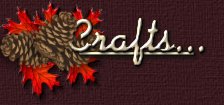
Cornucopia Centerpiece |
What you'll need:
Grapevine cornucopia basket from craft supply shop
60 tiny hemlock cones
15 dried galax leaves
10 small white lotus pods
6 sprigs of small rose hips
4 sprigs of pepper berries
Sheet moss
Scissors
Hot-glue gun and glue stick |
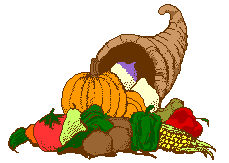 |
What you do:
- With the glue gun, attach the sheet moss randomly around the open end of the cornucopia, leaving sections of the rim exposed.
- Glue lotus pods in a cluster on each side of cornucopia, slightly below the rim. Arrange the galax leaves around the lotus pods and glue them in place.
- Fill in the exposed areas of the rim with clusters of hemlock cones.
- Glue a cluster of pepper berries on each side and a few sprigs of rose hips around the rim.
|
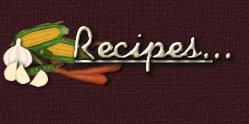
Acorn Squash with Brown Sugar-Pecan Topping |
A little something different for your Thanksgiving feast …
Ingredients:
2 small acorn squash (1 pound each)
1/2 teaspoon salt
2 tablespoons water
1/2 cup pecans or walnuts, chopped
1/4 cup packed light brown sugar
2 tablespoons margarine, melted |
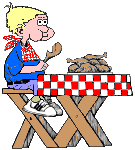 |
Preheat oven to 375 degrees. Cut each squash in half lengthwise; discard seeds. Place slices in a single layer in 15-1/2 by 10-1/2 inch jelly-roll pan; sprinkle with salt. Drizzle water around squash. Cover pan lightly with foil. Bake 30 minutes.
Meanwhile, in small bowl, stir nuts with brown sugar and margarine until combined. Spoon mixture evenly over squash. Bake uncovered for 15 minutes.
Makes four servings.
Preparation time: 15 minutes. Bake time: 45 minutes. Each serving: 320 calories, 4 gms protein, 49 gms carbohydrates, 15 gms total fat (2 gms saturated), 0 mg cholesterol, 350 mg sodium. |
Cranberry Bread |
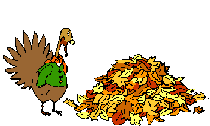 |
Ingredients:
2 cups flour (sifted)
1 cup sugar
1 and 1/2 teaspoon baking powder
1 teaspoon salt
1/2 teaspoon baking soda
1/4 cup butter
1 beaten egg
1 teaspoon grated orange peel
3/4 cup orange juice
1-1/2 cups light raisins (approximately)
1/2 bag chopped fresh cranberries |
Sift: flour, sugar, baking powder, salt, and baking soda. Cut in 1/4 cup butter until mixture is crumbly. Add egg, orange peel and orange juice. Mix until mixture is evenly moist. Fold in as many light raisins as you think looks good and the chopped cranberries per loaf. Spoon into a greased 9 x 5 x 3 loaf pan bake at 350°F for 1 hour and 10 minutes or until toothpick in center comes out clean. Cool out of pan on a wire rack. Keep stored in aluminum foil, unless you eat it all before it cools. |
Ginger Bread Men |
Ingredients:
3-1/4 cups flour
1/2 teaspoon baking soda
1/4 teaspoon salt
1 teaspoon ground cinnamon
2 teaspoon ground cloves
1 cup salted butter, softened
3/4 cup dark brown sugar, firmly packed
1 large egg
1/2 cup unsulfered molasses
2/3 cup confectioners sugar
1 - 2 teaspoon milk |
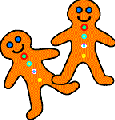 |
- Preheat oven to 325°F
- Whisk together flour, salt, cinnamon, baking soda, ginger, and cloves
- Cream butter and sugar. Scrape down sides of bowl. Add egg and molasses and beat on medium speed until smooth.
- Scrape down bowl and add flour mixture, blend on low speed until just combined -- do not over mix!
- Separate dough into 2 balls and flatten into disks. Wrap each disk tightly in plastic wrap and refrigerate 1 hour.
- On floured surface with floured rolling pin, roll dough out to 1/4" thickness. With floured cookie cutters cut into shapes. Gather scraps and re-roll dough until all is used. Place on ungreased baking sheets about 1/2" apart.
- Bake 9-11 minutes — do not brown. Transfer to cool, flat surface and cool.
Preparing Icing:
- Whisk sugar and milk until smooth but still liquid.
- Add extra milk if seems dry.
- Spoon icing into a pastry bag with small piping tip, or other icing dispenser.
- Decorate as desired.
|
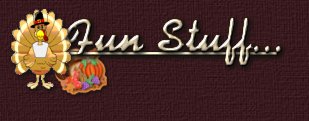
Coloring Fun |
 Coloring Page 1 Coloring Page 1 |
 Coloring Page 4 Coloring Page 4 |
 Coloring Page 3 Coloring Page 3 |
 Coloring Page 2 Coloring Page 2 |
 Coloring Page 5 Coloring Page 5 |
|
Here are some great links with lots more Thanksgiving ideas, recipes, crafts, and lots more!
 Thanksgiving crafts Thanksgiving crafts |
 History of the May Flower History of the May Flower |
 Free Screensaver! Free Screensaver! |
 A Kid's Heart Thanksgiving Page A Kid's Heart Thanksgiving Page |
 Black Dog Thanksgiving Pages Black Dog Thanksgiving Pages |
 Thanksgiving Resources Thanksgiving Resources |
 Holidays.net Holidays.net |
 Billy Bear's Holiday Pages Billy Bear's Holiday Pages |
HAPPY THANKSGIVING
by Marian Holbrook |
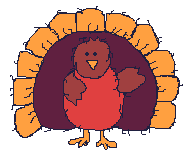 |
'Tis the night before Thanksgiving
And all through our house
No turkey is baking; I feel like a louse,
For I am all nestled, so snug in my bed;
I'm not gettin' Up and I'm not bakin' bread.
No pies in my oven, no cranberry sauce
Cuz I give the orders, and I am the boss.
When out in the kitchen, there arose such a clatter
I almost got up to see what was the matter.
As I drew in my head and was tossing around
To the bed came my husband, he grimaced, he frowned.
And laying his finger aside of his nose,
He scared me to death and I thought, "Here he goes!"
He spoke not a word as he threw back my quilt
And the look that he gave was intended to wilt.
So up to the ceiling my pillows he threw
I knew I had had it, his face had turned blue.
"You prancer, you dodger, you're lazy, you vixen
Out yonder in kitchen, Thanksgiving you're fixin"
But he heard me explain, with my face in a pout:
"I'm JUST TOO DARN TIRED and we're EATIN' OUT!"
|
The HTML, FLASH, JAVA, graphics and original descriptions contained on these pages are not public domain and are not available for download or use. Unless otherwise specified these are all the exclusive property of Copyright ©1994-2016 MOON Productions® The Rattt Trap, Cybele Designs and Designs by Char are owned by MOON Productions. All rights reserved. Best viewed at 1024 x 768 with IE 5.5 or higher.